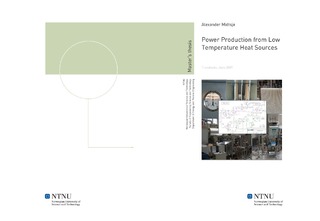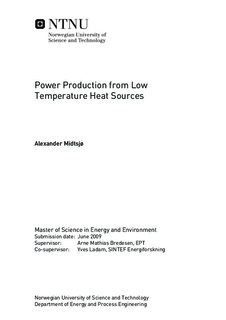| dc.contributor.advisor | Bredesen, Arne Mathias | nb_NO |
| dc.contributor.advisor | Ladam, Yves | nb_NO |
| dc.contributor.author | Midtsjø, Alexander | nb_NO |
| dc.date.accessioned | 2014-12-19T11:44:33Z | |
| dc.date.available | 2014-12-19T11:44:33Z | |
| dc.date.created | 2010-09-04 | nb_NO |
| dc.date.issued | 2009 | nb_NO |
| dc.identifier | 348829 | nb_NO |
| dc.identifier | ntnudaim:4595 | nb_NO |
| dc.identifier.uri | http://hdl.handle.net/11250/233668 | |
| dc.description.abstract | As part of the energy recovery part of the ROMA (Resource Optimization and recovery in the Materials industry) project, a laboratory prototype power production system is being built and completed in 2009. The laboratory prototype is based on a new technology for power production from low to medium temperature heat sources (the off gas from electrolysis cells in the aluminum industry) where CO2 is used as a working medium in a trans-critical Rankine cycle. The laboratory rig consists of the power cycle with a prototype expander as the core unit, an air loop to provide the heat, and an ethylene glycol loop to provide condensation of the working fluid in the power cycle. As a preparation to the assembling and instrumentation of the prototype rig, a simulation and an uncertainty analysis were conducted for the prototype rig in the autumn of 2008. This report focuses on the continuation of that work by an experimental investigation of the individual loops and the components of the prototype rig. The emphasis of this investigation has been put on the air loop and the expander unit of the power cycle. This is basically because these are of great importance to the performance of the power production prototype rig. The air loop was thoroughly tested, and from the investigations it was discovered that there was an unfavorable temperature distribution of the air going into the air-to-CO2 heat exchanger. This is the heat exchanger where heat is provided to the power cycle. The source for this temperature maldistribution was identified, and solutions were investigated to improve on the problem without results. The reduced performance of the air loop was incorporated in a new simulation of the power cycle in order to quantify the consequences for the optimization of the power cycle. The simulation was carried out for warm air temperature of 80 °C. The new calculations showed a reduction in maximum net work output of 27 % compared to the original simulation. The optimal conditions for the power cycle were also changed as a consequence of the reduced air loop performance. The investigation of the expander unit revealed that the expander isentropic efficiency was a strong function of the pressure difference across the expander, and a weak function of the expander inlet pressure. It also revealed that overall the isentropic efficiency was much less than the value of 80 % which was used in the original simulation. A new simulation of the power cycle was carried out where the expander isentropic efficiency was incorporated as a function of the pressure difference across the expander. This function was based on the data from the expander testing. The simulation showed a reduction in maximum net work output from 225 W to about 60 W, for warm air temperature of 80 °C. The new expander characteristics also affected the optimization of the power cycle. The simulation results and the results from the prototype investigation will be important in the optimization and control procedures of the assembled prototype power production system. | nb_NO |
| dc.language | eng | nb_NO |
| dc.publisher | Institutt for energi- og prosessteknikk | nb_NO |
| dc.subject | ntnudaim | no_NO |
| dc.subject | SIE5 energi og miljø | no_NO |
| dc.subject | Varme- og energiprosesser | no_NO |
| dc.title | Power Production from Low Temperature Heat Sources | nb_NO |
| dc.type | Master thesis | nb_NO |
| dc.source.pagenumber | 88 | nb_NO |
| dc.contributor.department | Norges teknisk-naturvitenskapelige universitet, Fakultet for ingeniørvitenskap og teknologi, Institutt for energi- og prosessteknikk | nb_NO |

